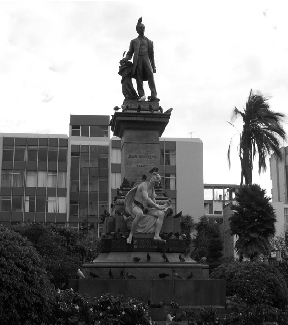Resumen
La escultura pública se edifica para civilizar el discurso del poder. En su intento por educar a la población en el respeto al orden establecido, el poder constituido pone en marcha, de manera sistemática, varios dispositivos: la ocupación del espacio público, la exaltación a la imagen, la alusión a la memoria cívica. Así, la escultura del escritor ecuatoriano,
Juan Montalvo (Ambato, Ecuador, 1832-1889), ha servido para establecer una fuerte conexión con uno de los “héroes” del pasado, cuya memoria ha servido para construir gran parte de la historia local contemporánea. Sin embargo, en los últimos años, la escultura ha sufrido varias agresiones. Las autoridades se han limitado a clasificarlas
como “hechos delictivos”, y no se han analizado o estudiado estos acontecimientos. Este artículo de reflexión, por tanto, plantea la pregunta: ¿Qué narra la agresión al conjunto escultórico de Montalvo? Para contestarla, presenta una lectura de la agresión en el contexto cultural actual que atraviesan la ciudad y sus habitantes. Su argumento es que el proyecto civilizatorio del poder constituido enfrenta gestos contestatarios que, lejos de ser negativos, pueden abrir la puerta a la inclusión de voces disidentes en la narración de su propia historia pública
La revista Apuntes se encuentra registrada bajo la licencia Creative Commons Reconocimiento 4.0 Internacional. Por lo tanto, esta obra se puede reproducir, distribuir y comunicar públicamente en formato digital, siempre que se reconozca el nombre de los autores y a la Pontificia Universidad Javeriana. Se permite citar, adaptar, transformar, autoarchivar, republicar y crear a partir del material, para cualquier finalidad (incluso comercial), siempre que se reconozca adecuadamente la autoría, se proporcione un enlace a la obra original y se indique si se han realizado cambios. La Pontificia Universidad Javeriana no retiene los derechos sobre las obras publicadas y los contenidos son responsabilidad exclusiva de los autores, quienes conservan sus derechos morales, intelectuales, de privacidad y publicidad.
El aval sobre la intervención de la obra (revisión, corrección de estilo, traducción, diagramación) y su posterior divulgación se otorga mediante una licencia de uso y no a través de una cesión de derechos, lo que representa que la revista y la Pontificia Universidad Javeriana se eximen de cualquier responsabilidad que se pueda derivar de una mala práctica ética por parte de los autores. En consecuencia de la protección brindada por la licencia de uso, la revista no se encuentra en la obligación de publicar retractaciones o modificar la información ya publicada, a no ser que la errata surja del proceso de gestión editorial. La publicación de contenidos en esta revista no representa regalías para los contribuyentes.


